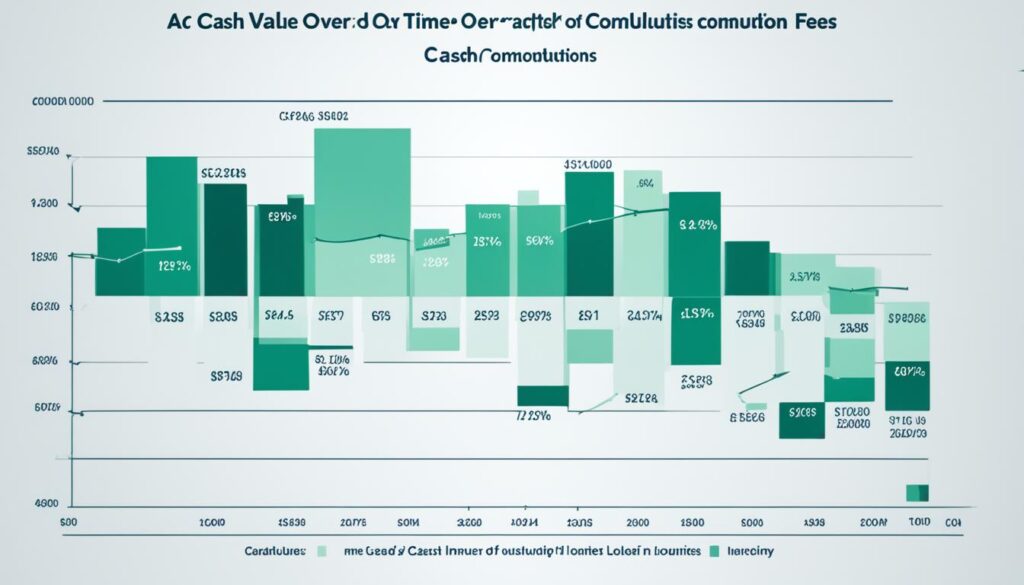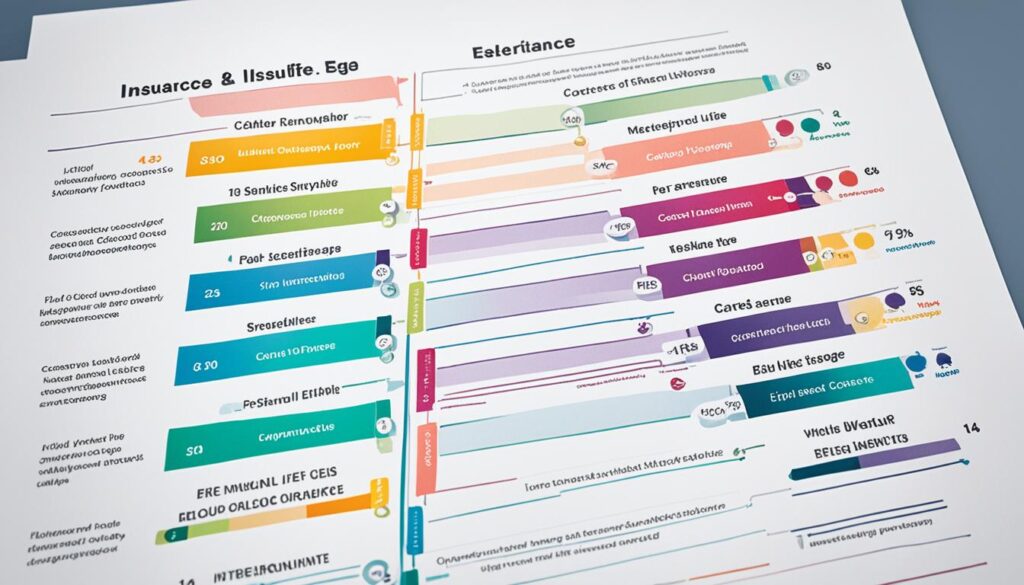About 30% of adults in the US own a Whole Life Policy. This shows how much people value it as a lifetime financial safety net. Life is full of surprises, but having financial security for the future is possible. Unlike term life insurance, Whole Life Insurance Coverage offers long-lasting protection. This kind of Permanent Life Insurance is meant to last your whole life. As long as you keep paying the premiums, you stay covered. It has a guaranteed, tax-free death benefit and a cash value savings account. This account grows over time, providing financial stability for the long haul.
The cash value part of Whole Life Insurance appeals to many. It grows with time, offering a source of funds that can be borrowed or withdrawn. But, taking money from it can lower the death benefit. It’s important to remember this when using your policy. One big plus is that the premiums never go up, making it easier for policyholders as they get older.
Key Takeaways
- Whole Life Insurance is a type of Permanent Life Insurance that ensures protection over the entirety of one’s life.
- A Whole Life Policy typically includes level premiums, meaning the cost doesn’t increase with age or health changes.
- The element of cash value accumulation allows the policy to operate not only as insurance but also as a tax-deferred savings account.
- Utilizing the cash value for loans or withdrawals is possible, though it impacts the guaranteed death benefit.
- Whole Life Insurance Coverage provides not just a safety net, but also potential financial opportunities for investment and wealth creation.
What Is Whole Life Insurance and How Does It Differ from Term Policies?
Whole Life Insurance offers long-term financial security and a Guaranteed Death Benefit. It’s different from short-term policies. Understanding its permanent nature, differences, and cash value benefits makes it clear. It’s a powerful financial tool.
Defining Whole Life Coverage and Its Permanence
Whole Life Insurance is a type of Cash Value Life Insurance that doesn’t expire if premiums are paid. This is different from term insurance, which lasts for a set time. Whole Life insurance gives lifetime coverage.
This provides peace of mind with a Guaranteed Death Benefit. Over time, policyholders build a cash reserve. This is on top of the insurance itself.
Comparing Whole Life with Term Insurance
Whole Life Insurance premiums stay the same over time. In contrast, term insurance can get more expensive as one ages. This is because it needs renewals.
Term policies end after a set term and offer nothing if the policyholder lives beyond this. But, Whole Life insurance has a savings part that grows. This ensures a death benefit and financial security for life.

Unpacking the Cash Value Benefit of Whole Life Policies
The cash value in Whole Life Insurance is an added investment feature. It allows policyholders to take out loans or make withdrawals. Often, this is tax-free up to the paid premiums.
This is not possible with term insurance. So, Whole Life policies are good for securing present and future finances.
| Feature | Whole Life Insurance | Term Insurance |
|---|---|---|
| Duration of Coverage | Lifetime | Specific Term Period |
| Premium Stability | Consistent over time | Increases at renewal |
| Financial Benefits | Death benefit + Cash value accumulation | Death benefit only |
| Utility of Policy | Life coverage and savings/investment vehicle | Pure life coverage |
Understanding Whole Life Insurance vs. term policies makes a complex topic simple. It helps in making smart choices for long-term financial planning. Using life insurance wisely is key in estate or retirement planning.
Whole Life Insurance: Guaranteed Death Benefit Explained
The Whole Life Insurance Coverage offers a guaranteed death benefit. This key feature gives a tax-free large sum to policyholders’ beneficiaries after death. It is unique because it assures a payout and might grow through reinvested dividends.

Death Benefit Life Insurance becomes more appealing with accidental death riders and waiver of premium riders. But, remember that outstanding policy loans or withdrawals reduce the death benefit amount.
Beneficiaries have options on how they receive the death benefits. They can get it all at once, in parts, or as annuity payments. Each choice impacts taxes differently, especially regarding interest accrued with annuities.
| Beneficiary Payment Option | Details | Tax Implications |
|---|---|---|
| Lump Sum | Full amount paid immediately upon death of insured | No federal income tax on benefits |
| Installments | Spread out payments over a period of time | Interest part of payments may be taxable |
| Annuitization | Converts benefit into an annuity to provide regular income | Part of each payment taxed as ordinary income |
It’s important to know how the Guaranteed Death Benefit Explained in your Whole Life Insurance Coverage works. This ensures your loved ones get maximum value and security. Every part, from accidental death benefits to rider options, contributes to the overall advantage of Death Benefit Life Insurance.
The Mechanics of Cash Value in Whole Life Policies
Getting to know how Cash Value Life Insurance works inside a Whole Life Policy is key for policyholders. They can use it to better their financial planning. This part of the policy is more than just a backup. It grows over time, showing how strong a Permanent Life Insurance plan is.
Growth and Tax-Deferred Nature of the Cash Value
The cash value in a whole life policy grows similar to retirement savings, but it’s tax-deferred. This means policyholders see their value go up without the tax hit. It builds a stronger financial foundation as the years go by.
Accessing Funds: Withdrawals and Loans Explained
Policyholders have ways to get to their funds when needed. They can take out money up to what they’ve paid in premiums without taxes. This gives them an easy way to get cash without losing out. They can also borrow against the cash value. This can help in tough times, but remember, the loans build up interest. This needs attention to keep the policy’s value safe.

Impact of Withdrawals and Loans on the Death Benefit
Taking money out or borrowing from the cash value has immediate benefits. But, it’s important to know it can lower the death benefit. This means the money left for your family could be less. Keeping this balance is crucial for the ongoing security a Whole Life Policy aims to give to loved ones.
Strategic Uses of Whole Life Insurance
Whole Life Insurance is not just for life coverage. It’s also a key financial strategy. It provides reliable security, helping with legacy planning and keeping businesses stable.
Providing Lifelong Financial Security and Legacy Planning
Whole Life Insurance gives financial peace of mind. It ensures your loved ones are okay and your wealth goes to the right hands. It helps families keep their lifestyle and reach big goals like education.
Investment and Retirement Funding Capabilities
The cash value in Whole Life Insurance is smart for planning ahead. Paying premiums regularly increases this cash value. It then becomes extra money for retirement or when money gets tight.
Whole Life for Business: Key Employee Protection and Succession Planning
For businesses, Whole Life Insurance keeps things running smoothly. It protects against losing key employees suddenly. It also helps when transferring ownership.
| Feature | Benefit |
|---|---|
| Lifelong Coverage | Ensures enduring security and support for beneficiaries’ future needs. |
| Cash Value Growth | Acts as a financial cushion that can be utilized during retirement or financial need. |
| Business Continuity | Provides financial stability and facilitates smooth transitional planning. |

Conclusion
Whole life insurance is a key to financial stability, lasting a lifetime. It’s different from term life policies because it offers guaranteed death benefits. This means peace of mind knowing your loved ones will be financially secure.
The policy doesn’t just protect. It’s also an asset that helps in future planning. Its cash value grows over time, making it a smart choice for financial security.
Choosing this insurance is a long-term move with big benefits. Fixed premiums make it predictable. It meets the needs of those who want a solid financial plan.
The cash value comes with lots of options. You can take out loans, invest it, or have an emergency fund. These features help meet personal financial goals.
Deciding on whole life insurance requires careful thought. It’s important to balance the cost, benefits, and your financial dreams. Understanding how these policies work leads to long-term financial safety.
With whole life insurance, you protect your legacy and build wealth for your family. It offers a secure future and peace of mind for all.
FAQ
What Is Whole Life Insurance and How Does It Differ from Term Policies?
Whole life insurance is a type of life insurance that lasts your whole life. It has a cash value that grows over time. Term policies only last for a certain time and have no cash value.
What Is a Guaranteed Death Benefit in Whole Life Insurance?
The guaranteed death benefit is the money that will be paid out when the insured person dies. It’s tax-free. Sometimes, this amount can go up if policy dividends are put back into the policy.
How Does the Cash Value Component Work in Whole Life Policies?
The cash value in whole life policies is like a savings account that grows without taxes. You can borrow from it or use it to pay for the policy. As time goes on, this can add to the policy’s worth.
Can the Cash Value in Whole Life Insurance Be Accessed Without Penalty?
You can get to the cash value with loans or withdrawals. Withdrawals are tax-free up to what you’ve paid in. Loans are usually tax-free too. But, if you don’t pay them back, they can lower the death benefit and might cause taxes if the policy ends.
What Is the Impact of Loans or Withdrawals on the Death Benefit of a Whole Life Policy?
When you take loans or withdrawals, it reduces the death benefit by the same amount. If these aren’t paid back, the beneficiaries get less money when the policyholder dies.
How Can Whole Life Insurance Serve as a Strategic Financial Tool?
Whole life insurance can help with financial planning, leaving money for your family, and covering big expenses. Businesses also use it to keep things stable if a key person leaves or to plan ahead for passing the business on.
Can Whole Life Insurance Be Used for Retirement Planning?
Yes, you can use the cash value in the policy as extra money when you retire. It’s important to think about how taking out money affects keeping the policy active and covering you.
Does Whole Life Insurance Make Sense for Estate Planning?
Whole life insurance is good for estate planning because the death benefit can pay taxes, debts, or give an inheritance. It leaves a financial legacy for the ones you leave behind.
Are There Advantages to Using Whole Life Insurance in Business Planning?
Whole life insurance helps in business by protecting against the loss of a key employee and helping with agreement plans. It also makes employee benefits better. The policy’s cash value can be used in business funding.



